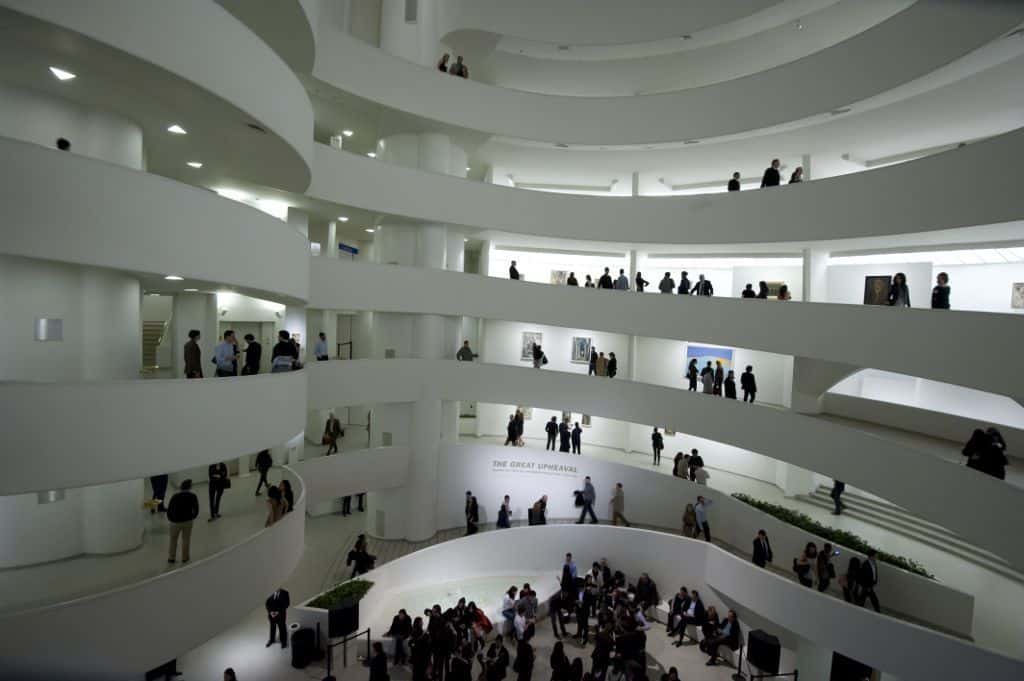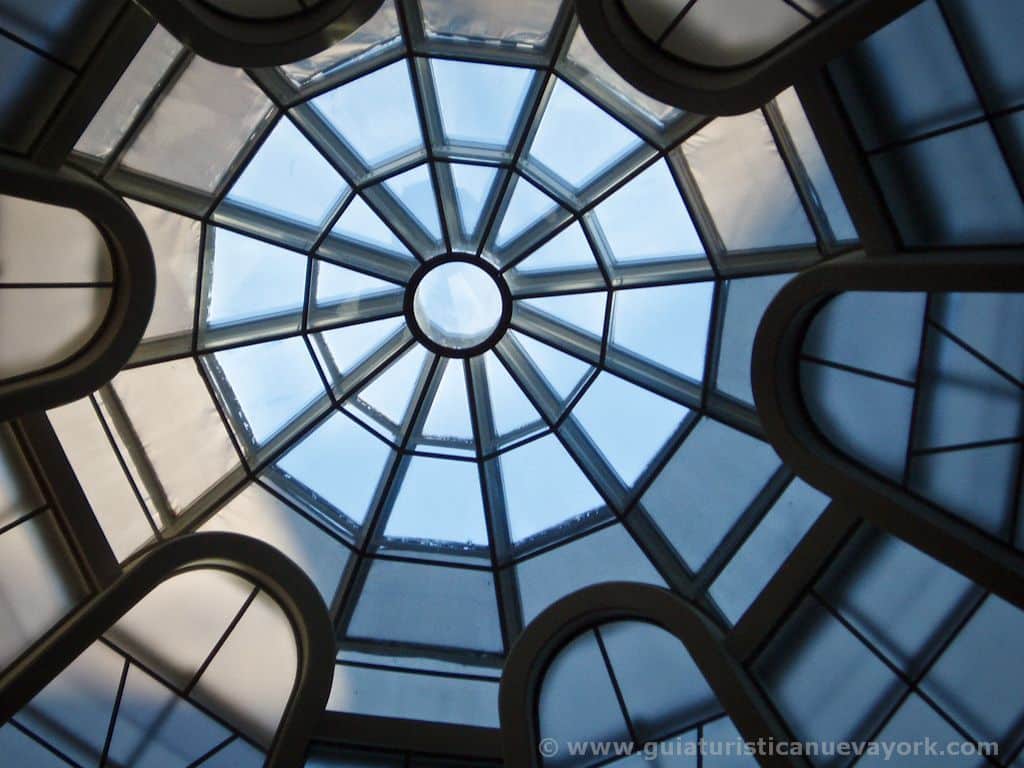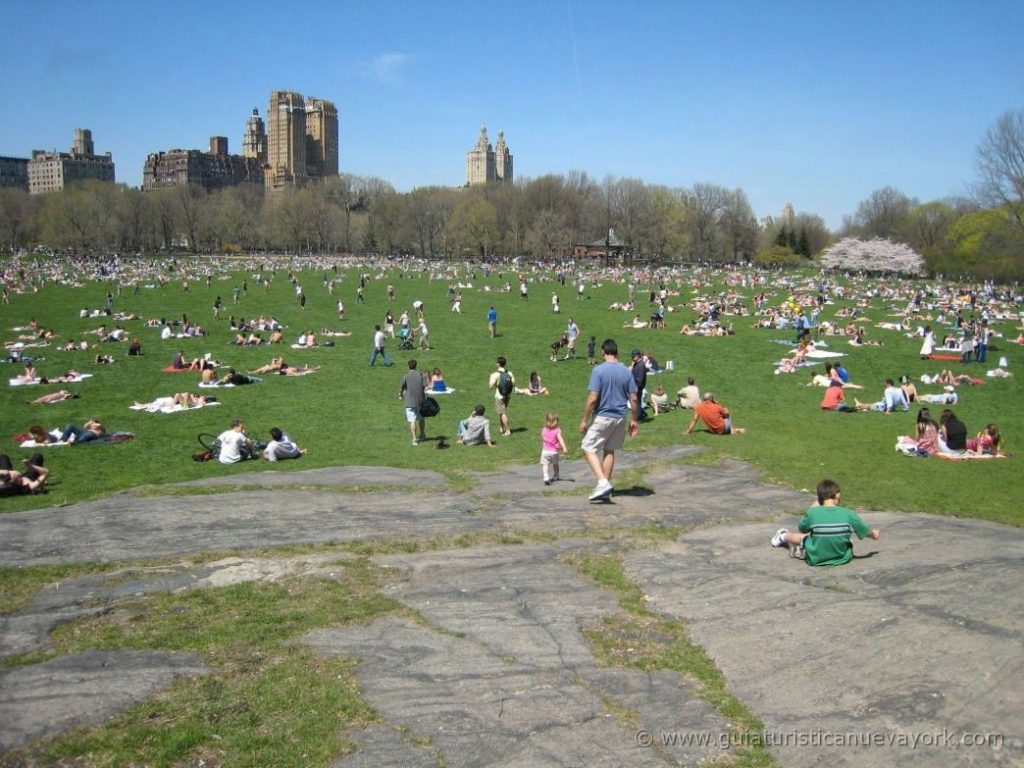El museo Solomon R. Guggenheim Nueva York, diseñado por Frank Lloyd Wright, es uno de los hitos arquitectónicos más importantes del siglo XX. Situado en el Upper East Side, justo al lado de Central Park, el museo Guggenheim, con su característica silueta en espiral, se ha convertido en uno de los emblemas de la ciudad de Nueva York.
El museo abrió sus puertas por primera vez el 21 de octubre de 1959, seis meses después de la muerte de Frank Lloyd Wright y diez años después de la muerte del fundador Solomon Guggenheim.
Contenido
Breve historia del museo Solomon R. Guggenheim
El museo debe su nombre a su fundador, Solomon R. Guggenheim, un magnate americano que, alentado y guiado por la artista y asesora de arte Hilla Rebay, inició una colección de arte a finales de los años veinte.
Rebay era seguidora del pintor de origen ruso Vasily Kandinsky, por lo que animó a Guggenheim a coleccionar la obra de Kandinsky (más de cien cuadros en la colección del museo), así como la de otros artistas, como Rudolf Bauer y László Moholy-Nagy.
Al principio, la propia suite de Guggenheim en el Hotel Plaza de Nueva York servía como espacio de exposición para su colección de arte. Más adelante, en 1937, cuando su colección había crecido demasiado para albergarla en su apartamento, Guggenheim creó la Fundación Solomon R. Guggenheim.
Dos años más tarde, la Fundación abrió su primer museo: el Museum of Non-Objective Painting (Museo de Pintura No Objetiva), en la calle E 54th de Manhattan, bajo la dirección de Hilla Rebay. Cuatro años después, la Fundación pidió al innovador arquitecto Frank Lloyd Wright que diseñara un edificio permanente para albergar la creciente colección de arte de Guggenheim, que en ese momento incluía ya obras de Marc Chagall, Robert Delaunay, Fernand Léger, Amedeo Modigliani, László Moholy-Nagy y Pablo Picasso. Wright empleó 16 años, 700 bocetos y seis conjuntos de planos diferentes hasta completar el proyecto.
El edificio de Frank Lloyd Wright
El encargo de construir un museo que albergue la colección de arte de Solomon R. Guggenheim llegó a Wright de manos de Hilla Rebay. El encargo a Wright culminó en una de las mayores obras de arquitectura del siglo XX: un edificio tan famoso como la colección de arte para cuya exposición fue diseñado.
Wright tuvo en mente diversos emplazamientos en Nueva York antes de decantarse por la actual ubicación en la Quinta Avenida, entre las calles 88 y 89. La cercanía a Central Park era fundamental para Wright: no sólo proporcionaba un auténtico descanso del ruido y el tráfico de la ciudad, sino que además era una fuente de inspiración.
El deseo de Wright era trasladar las formas orgánicas de la naturaleza a la arquitectura. La espiral que diseñó para el Guggenheim Museum evoca la concha de un nautilo, con espacios continuos que fluyen libremente uno dentro del otro.
Rechazando los modelos de museo tradicionales, que llevaban a los visitantes a través de una serie de salas unidas entre sí y les obligaban a volver sobres sus pasos al salir, la innovadora idea de Wright era llevar rápidamente a la gente al piso superior del edificio en un ascensor para que desde allí pudiesen descender a pie la suave rampa continua y circular mientras contemplaban las diferentes obras de arte expuestas.
Para alcanzar la cercanía y escala humana, Wright pensó que los cuadros debían inclinarse ligeramente hacia atrás, como si estuvieran sobre un caballete, apoyados en la base oblicua de los muros ligeramente inclinados hacia el exterior. Sin embargo, el primer director y los miembros del patronato del museo decidieron exponer los cuadros sostenidos por barras que los proyectaban hacia el exterior, alejados de las paredes. En 1961, Thomas Messer asumió la dirección del museo y recuperó la idea original de Wright.
La circularidad es una constante en el edificio de Wright que se refleja en todas partes, desde la rotonda y el tragaluz, hasta detalles como el diseño de los suelos de terrazo. Pero también hay triángulos, óvalos y cuadrados: la obra maestra de la última etapa de la carrera de Wright ofrece su personal interpretación de la geometría de la arquitectura modernista.
Al igual que hacía con casi todos los proyectos en los que trabajaba, Frank Lloyd Wright insistió en diseñar casi hasta el último detalle, desde las sillas hasta los ascensores.
Desafortunadamente, la inflación de la posguerra, los cambios en la ubicación del edificio y las exigencias del código de construcción, entre otros factores, retrasaron la construcción durante muchos años y obligaron a realizar incontables revisiones del diseño y de los planos de Wright. Aun así, el 21 de octubre de 1959 el Guggenheim Museum abría sus puertas a la enorme multitud que llevaba horas haciendo cola en la Quinta Avenida esperando verlo por primera vez.
Tanto entonces como ahora, el monumento de Wright a la modernidad, con su rampa en espiral, su rotonda y su cúpula con tragaluz fascina a los visitantes ofreciendo un espacio único en el que vivir el arte. La gran rotonda iba además acompañada de otra rotonda más pequeña y una torre diseñadas originalmente para albergar estudios para artistas y apartamentos para Rebay y Guggenheim.
En 1990 se realizan unas obras de ampliación del museo que finalizan en 1992 y que añaden dos nuevas plantas para oficinas, cuatro galerías de exposición más y la reapertura de la rampa superior de la rotonda (en la 6ª planta), consiguiendo un circuito de visita ininterrumpido y cumpliendo así la visión original de Wright para el museo.
Wright logró un edificio brillante cuya arquitectura resulta tan novedosa hoy en día como lo fue hace cincuenta años. Cuando el museo abrió por primera vez, algunos, entre ellos artistas, criticaron a Wright por crear un entorno museístico tan inusual que amenazaba con eclipsar al arte que contenía. Con los años, sin embargo, artistas y comisarios de arte han encontrado en el museo un alentador desafío e incluso han utilizado el edificio como inspiración a la hora de crear obras concebidas específicamente para su espacio.
El Museo Solomon R. Guggenheim se erige como testamento elocuente del genio arquitectónico de Wright y del espíritu aventurero fundacional que lo hizo posible.
La colección permanente del museo
La historia del museo Solomon R. Guggenheim Nueva York es en esencia la historia de muchas y diversas colecciones privadas que han ido aumentando (y siguen haciéndolo) a lo largo de los años gracias a importantes donaciones y adquisiciones, dando lugar a una rica y polifacética colección permanente que se remonta a finales del siglo XIX y llega hasta nuestros días.
Estas son los principales hitos de la creación de la colección actual del museo:
- Entre 1937 y 1949, Solomon Guggenheim donó a la Fundación Guggenheim aproximadamente 600 obras de arte de artistas como Marc Chagall, Vasily Kandinsky, Piet Mondrian o Pablo Picasso.
- La donación de la preciada colección de Justin K. Thannhauser, formada por obras maestras del Impresionismo, el postimpresionismo y el arte moderno francés, y que incluye obras de Vincent van Gogh, Edouard Manet, Pablo Picasso y Camille Pissarro, amplió considerablemente el abanico histórico de la colección Guggenheim.
- A principios de los noventa, el Guggenheim adquirió más de 350 obras de arte minimalista, posminimalista y conceptual de la afamada colección del Conde Giuseppe Panza di Biumo y su esposa Giovanna, dando una mayor profundidad y calidad a los fondos de la posguerra.
- En 1948, la Fundación Guggenheim amplió los fondos de su colección con la adquisición del patrimonio completo del marchante de arte de Nueva York Karl Nierendorf (1889-1947), que incluía trabajos de importantes artistas expresionistas alemanes y austríacos, pintores surrealistas como Joan Miró y obras en papel de Paul Klee, además de algunos de los primeros cuadros del expresionista abstracto Adolph Gottlieb.
- En 1953, la Fundación Guggenheim recibió el pequeño pero importante legado de una de las figuras más influyentes del mundo del arte del siglo XX: Katherine S. Dreier (1877-1952). Éste incluía importantes obras, como La niña francesa de Brancusi (1914-18), una escultura en bronce de Archipenko (1919), un móvil de pie de Calder (1935), una naturaleza muerta sin título de Juan Gris (1916) y tres collages datados entre los años 1919 y 1921 del dadaísta alemán Kurt Schwitters.
- Gracias a sus continuos contactos con artistas a lo largo de toda su vida, Hilla Rebay (que fue la primera en asumir la dirección del Guggenheim), reunió una importante colección de arte propia. Parte de dicha colección, incluidas obras de Kandinsky, Klee, Mondrian y Schwitters, fue donada al Guggenheim Museum en 1971, cuatro años después de su muerte.
- En 1992, la Fundación Robert Mapplethorpe, nombró a la Fundación Guggenheim beneficiaria de unas 200 de las mejores fotografías y objetos únicos de Mapplethorpe. La donación, que se llevó a cabo en varias fases, convirtió el Guggenheim en el mayor depositario público de la obra de este importante artista americano, inaugurando además la colección y el programa de exposiciones de fotografía del museo.
- En 2001, la Fundación Bohen, una institución benéfica privada, donó al Guggenheim 275 obras de 45 artistas diferentes, con el objetivo central de ampliar enormemente la colección del museo de películas, vídeos y nuevas tecnologías que representan la dinámica y vital intersección del arte con el nuevo milenio. Las obras donadas van desde los importantes trabajos fotográficos de Hiroshi Sugimoto, Sam Taylor-Wood y Sophie Calle hasta instalaciones que ocupan toda una sala e incorporan vídeos a gran escala de Iñigo Manglano-Ovalle, Pierre Huygue y Willi Doherty.
Horario del museo Guggenheim Nueva York
- Lunes: 11 am–6:00 pm
- Martes: 11 am–6:00 pm
- Miércoles: 11 am–6:00 pm
- Jueves: 11 am–6:00 pm
- Viernes: 11 am–6:00 pm
- Sábado: 11 am–8:00 pm (de 6:00–8:00 pm entras pagando la voluntad)
- Domingo: 11 am–6:00 pm
- Cerrado el día de Acción de Gracias y el 25 de diciembre.
Tarifas (año 2023)
- Adultos $25
- Estudiantes y jubilados (mayores de 65 años) con documento identificativo $18
- Niños menores de 12 años: Gratis
- Entrada por la voluntad al museo los sábados de 18:00 a 20:00 horas.
¿Cómo llegar al Guggenheim?
- Coger la línea 4, 5 o 6 de metro y bajarse en la parada 86th Street. Andar hacia el oeste de la calle 86th, girar a la derecha en la Quinta Avenida y subir hasta la calle 88th.
Más información
Para más información del museo y descubrir las exposiciones temporales que se están realizando actualmente en el mismo, os recomiendo visitar la web oficial del Museo Solomon R. Guggenheim, en inglés.
Esta guía del Museo Guggenheim fue publicada por primera vez en marzo de 2008 y ha sido actualizada por última vez en mayo de 2023








